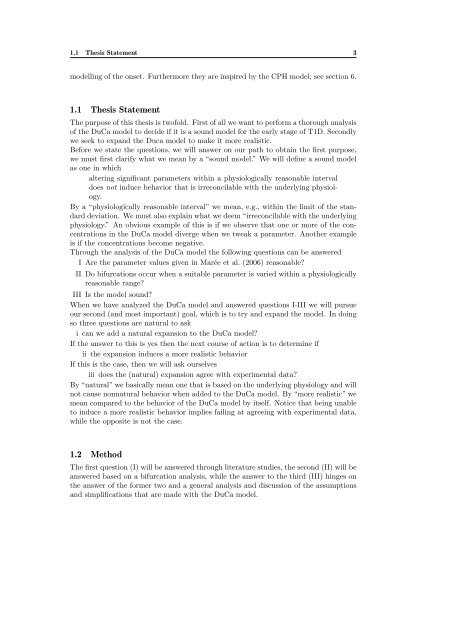nr. 477 - 2011 - Institut for Natur, Systemer og Modeller (NSM)
nr. 477 - 2011 - Institut for Natur, Systemer og Modeller (NSM)
nr. 477 - 2011 - Institut for Natur, Systemer og Modeller (NSM)
You also want an ePaper? Increase the reach of your titles
YUMPU automatically turns print PDFs into web optimized ePapers that Google loves.
1.1 Thesis Statement 3<br />
modelling of the onset. Furthermore they are inspired by the CPH model; see section 6.<br />
1.1 Thesis Statement<br />
The purpose of this thesis is twofold. First of all we want to per<strong>for</strong>m a thorough analysis<br />
of the DuCa model to decide if it is a sound model <strong>for</strong> the early stage of T1D. Secondly<br />
we seek to expand the Duca model to make it more realistic.<br />
Be<strong>for</strong>e we state the questions, we will answer on our path to obtain the first purpose,<br />
we must first clarify what we mean by a “sound model.” We will define a sound model<br />
as one in which<br />
altering significant parameters within a physiol<strong>og</strong>ically reasonable interval<br />
does not induce behavior that is irreconcilable with the underlying physiol<strong>og</strong>y.<br />
By a “physiol<strong>og</strong>ically reasonable interval” we mean, e.g., within the limit of the standard<br />
deviation. We must also explain what we deem “irreconcilable with the underlying<br />
physiol<strong>og</strong>y.” An obvious example of this is if we observe that one or more of the concentrations<br />
in the DuCa model diverge when we tweak a parameter. Another example<br />
is if the concentrations become negative.<br />
Through the analysis of the DuCa model the following questions can be answered<br />
I Are the parameter values given in Marée et al. (2006) reasonable?<br />
II Do bifurcations occur when a suitable parameter is varied within a physiol<strong>og</strong>ically<br />
reasonable range?<br />
III Is the model sound?<br />
When we have analyzed the DuCa model and answered questions I-III we will pursue<br />
our second (and most important) goal, which is to try and expand the model. In doing<br />
so three questions are natural to ask<br />
i can we add a natural expansion to the DuCa model?<br />
If the answer to this is yes then the next course of action is to determine if<br />
ii the expansion induces a more realistic behavior<br />
If this is the case, then we will ask ourselves<br />
iii does the (natural) expansion agree with experimental data?<br />
By “natural” we basically mean one that is based on the underlying physiol<strong>og</strong>y and will<br />
not cause nonnatural behavior when added to the DuCa model. By “more realistic” we<br />
mean compared to the behavior of the DuCa model by itself. Notice that being unable<br />
to induce a more realistic behavior implies failing at agreeing with experimental data,<br />
while the opposite is not the case.<br />
1.2 Method<br />
The first question (I) will be answered through literature studies, the second (II) will be<br />
answered based on a bifurcation analysis, while the answer to the third (III) hinges on<br />
the answer of the <strong>for</strong>mer two and a general analysis and discussion of the assumptions<br />
and simplifications that are made with the DuCa model.
















